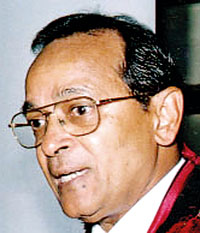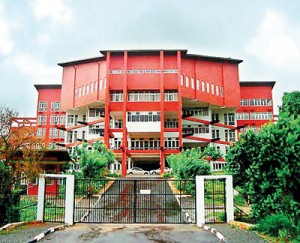Sunday Times 2
Private medical colleges: Don’t make it a business
View(s):The controversy-ridden South Asian Institute of Technology and Medicine (SAITM) was the topic of a recent lecture delivered by eminent Senior Surgeon Prof. A.H. Sheriffdeen as the guest-of-honour at the foundation sessions of the Sri Lanka Medical Association (SLMA). Excerpts:

Senior Surgeon Prof. A.H. Sheriffdeen
One of the objectives of the SLMA is to play an advocacy role in the medical affairs of the country. It was only two weeks ago that I saw some news items in the newspaper and I thought it is time to air my view on private medical colleges with the hope that the SLMA will take on the task of advising the Government on this contentious issue. In an article on Donald Trump, the correspondent had this to say: “He emerged amid a constellation of crises, economic hardships and unemployment, an erosion of political centre and a growing resentment against the elites. He had a penchant for long rambling speeches, presenting himself in messianic terms, promising to lead his country to a new era of greatness” – Donald Trump? Boris Johnson? Rodrigo Duterte? No, it is about Adolf Hitler!
“Why this fuss over SAITM?” asks a reader. The answer is the same – because of the hidden dangers.
Many years ago, I wrote to this very same newspaper that I have been asked on several occasions whether I was for or against private medical colleges and I had replied that I was neither for nor against these but that I was against unregulated “commercial” medical colleges which were akin to mere tutories. Of late, I have been approached by a few businessmen who have asked me, “Doctor, will you help me set up a private medical college? You name your price and we will pay you.”
And the conversation on each occasion has gone like this – “Have you got a teaching hospital?” -Answer “no”.
“Do you have any idea of medical curriculum, teaching medicine?” Answer “no”.
“Have you got capital?” Answer “no”.

The private medical college SAITM at Malabe
“Have you got permission to start a degree-awarding institution/medical school?” Answer: “No doctor, but when SAITM gets the ok we can advertise, collect five to 10 million rupees from each applicant, start with a lecture hall and later build up the rest – just like our international schools!”
Following the 1920s, the training of doctors in the United States moved from commercial medical schools to medical colleges with research facilities associated with teaching hospitals. Emphasis on the scientific basis of medicine stimulated major breakthroughs in our understanding of human biology and disease and this fostered progress. The triumvirate of medical school, research faculty, and teaching hospital spawned the modern academic medical centres with the following objectives:
- Educate and train tomorrow’s doctors and medical scientists
- Discover new medical knowledge and conduct research to find tomorrow’s cures (almost a hundred and fifty years later, how many of our medical faculties have this in their mission statements?)
- Develop innovative ways to prevent, diagnose and treat disease
- Provide the most up to date medical care
We too should move forwards not backwards.
The first step in establishing a medical school is to get permission from the Ministry of Higher Education and the Sri Lanka Medical Council (SLMC). There is a document issued from the SLMC titled ‘Guidelines and specifications and criteria for accreditation of medical schools in Sri Lanka and courses of study provided by them’ dated 2011.
These were first published in February 2009 under the provisions of Section 19 of the Medical Ordinance, in conformity with the Committee of Vice Chancellors, Directors of the University Grants Commission (UGC) of Sri Lanka for medical schools and foreign medical schools to be approved as centres of medical education for Sri Lankan citizens.
Since then the World Health Organization (WHO) in November 2009 published ‘guideline for accreditation of medical schools in countries of the South East Asia region’ “bearing in mind the country-specific requirements and the prevailing national accreditation practice which are non-binding, flexible and facilitatory in nature and are under the jurisdiction of the medical councils”.
“It is proposed that with the following standards of medical education by every university, medical school or degree awarding institute established under the Universities Act No. 16 of 1978 accreditation shall be periodically undertaken by the SLMC in accordance with Part 111 A of the Medical Ordinance.”
The process starts in the following sequence: Application for accreditation, scrutiny of documents, self evaluation, site visit, approval of curriculum/substantial changes.
This is followed by a set of guidelines on standards, educational programme, instructional methods and assessments. The next section is on clinical teaching facilities. It spells out the minimum number of beds and occupancy, the specialties, professorial units, clinicians, operating theatres, radiology facilities, laboratory facilities and rehabilitation. The next section is finances and resources with a sum of money deposited by private medical schools as a guarantee against eventualities!
Physical facilities like lecture rooms, auditorium and examination hall, tutorial rooms, AV Unit, laboratories and museums, library, information technology, clinical skills and English competency laboratories, research environment, medical education unit, accommodation and sports, food service, water supply, sanitation, electricity, gas and central workshop are spelt out.
Next is a section on student selection, staffing policy, staff development and PG development. The last section is the accreditation report. It says “the report must conclude with recommendations concerning the decision on accreditation to be taken by the SLMC, this decision must be conveyed to the Minister of Health, Minister of Higher Education and UGC and also made public”.
Now compare this with the guidelines put out by the Medical Council of India. There is an official gazette titled ‘Establishment of Medical Colleges 1999’. The first clear statement goes “No person shall establish a medical college except after obtaining prior approval from the central Government submitting a scheme: Single plot of land 25 acres in extent, Essentiality certificate: No objection of State/territory of administration, availability of adequate clinical material as per council regulations, university consent, person manages a hospital not less than 300 beds with facilities for expansion, that the person has not admitted students to the proposed medical college, bank guarantees in favour of the Medical Council of India, opening of medical colleges in hired or rented buildings shall not be permitted, market survey and environmental analysis, educational programme with method of recruitment, administration, department wise and year wise curriculum of students, functional programme – department wise and service wise, Equipment programme, manpower programme, building programme, planning and layout, Revenue and expenditure assumptions, Application with 3.5 lakhs to the Medical Council of India. This is followed by a review process by the MCI on desirability and feasibility, report by MCI, Grant of permission with a time based programme. (www.mcindia.org/for-colleges/Estl-of-new-Med-Coll-Regulations-1999.pdf)
You may now see the process set up of a step wise transparent process starting with a plot of land and resources, to obtaining national/state/territorial permission, teaching hospital/departments, infrastructure facilities, curriculum/criteria for recruitment of staff, admission of students and that at each stage the MCI is involved in assessing adequacy before final permission is given.
Compare this with the business entrepreneurs who are waiting to make a quick buck by commencing at the reverse end by recruiting the students, collecting the money, starting preclinical courses in hired halls, stepwise hiring of staff as required, ad hoc appointment of professors and lecturers, then building a teaching hospital and finally applying for permission from the medical council.
Maybe some will see now the answer to the question “Why this fuss over SAITM?”
I hope the SLMC will get involved:
- Sub committee to study the problem.
- Lobby the Government for a policy on private medical schools.
- Accept the fact that private medical schools are a necessary evil/ inevitable phenomenon.
- Re-write the guidelines using the MCI format.
- Close all loopholes which could enable corrupt practices.
- Lobby with the Government for gazette notification.
- Ensure punitive action in case of non-conformity.

